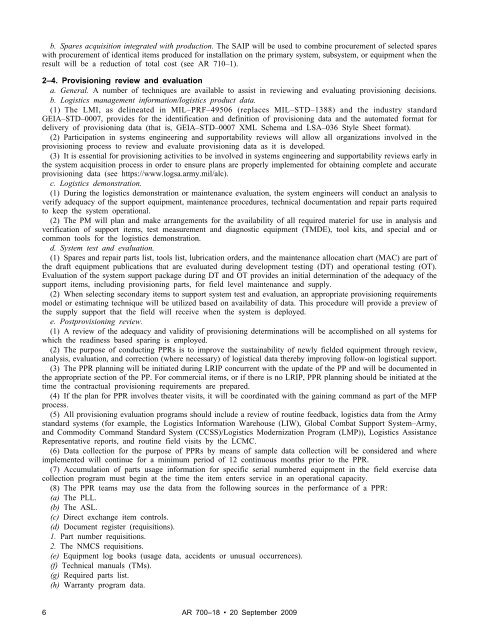Provisioning of U.S. Army Equipment - Army Publishing Directorate ...
Provisioning of U.S. Army Equipment - Army Publishing Directorate ...
Provisioning of U.S. Army Equipment - Army Publishing Directorate ...
Create successful ePaper yourself
Turn your PDF publications into a flip-book with our unique Google optimized e-Paper software.
. Spares acquisition integrated with production. The SAIP will be used to combine procurement <strong>of</strong> selected spares<br />
with procurement <strong>of</strong> identical items produced for installation on the primary system, subsystem, or equipment when the<br />
result will be a reduction <strong>of</strong> total cost (see AR 710–1).<br />
2–4. <strong>Provisioning</strong> review and evaluation<br />
a. General. A number <strong>of</strong> techniques are available to assist in reviewing and evaluating provisioning decisions.<br />
b. Logistics management information/logistics product data.<br />
( 1 ) T h e L M I , a s d e l i n e a t e d i n M I L – P R F – 4 9 5 0 6 ( r e p l a c e s M I L – S T D – 1 3 8 8 ) a n d t h e i n d u s t r y s t a n d a r d<br />
GEIA–STD–0007, provides for the identification and definition <strong>of</strong> provisioning data and the automated format for<br />
delivery <strong>of</strong> provisioning data (that is, GEIA–STD–0007 XML Schema and LSA–036 Style Sheet format).<br />
(2) Participation in systems engineering and supportability reviews will allow all organizations involved in the<br />
provisioning process to review and evaluate provisioning data as it is developed.<br />
(3) It is essential for provisioning activities to be involved in systems engineering and supportability reviews early in<br />
the system acquisition process in order to ensure plans are properly implemented for obtaining complete and accurate<br />
provisioning data (see https://www.logsa.army.mil/alc).<br />
c. Logistics demonstration.<br />
(1) During the logistics demonstration or maintenance evaluation, the system engineers will conduct an analysis to<br />
verify adequacy <strong>of</strong> the support equipment, maintenance procedures, technical documentation and repair parts required<br />
to keep the system operational.<br />
(2) The PM will plan and make arrangements for the availability <strong>of</strong> all required materiel for use in analysis and<br />
verification <strong>of</strong> support items, test measurement and diagnostic equipment (TMDE), tool kits, and special and or<br />
common tools for the logistics demonstration.<br />
d. System test and evaluation.<br />
(1) Spares and repair parts list, tools list, lubrication orders, and the maintenance allocation chart (MAC) are part <strong>of</strong><br />
the draft equipment publications that are evaluated during development testing (DT) and operational testing (OT).<br />
Evaluation <strong>of</strong> the system support package during DT and OT provides an initial determination <strong>of</strong> the adequacy <strong>of</strong> the<br />
support items, including provisioning parts, for field level maintenance and supply.<br />
(2) When selecting secondary items to support system test and evaluation, an appropriate provisioning requirements<br />
model or estimating technique will be utilized based on availability <strong>of</strong> data. This procedure will provide a preview <strong>of</strong><br />
the supply support that the field will receive when the system is deployed.<br />
e. Postprovisioning review.<br />
(1) A review <strong>of</strong> the adequacy and validity <strong>of</strong> provisioning determinations will be accomplished on all systems for<br />
which the readiness based sparing is employed.<br />
(2) The purpose <strong>of</strong> conducting PPRs is to improve the sustainability <strong>of</strong> newly fielded equipment through review,<br />
analysis, evaluation, and correction (where necessary) <strong>of</strong> logistical data thereby improving follow-on logistical support.<br />
(3) The PPR planning will be initiated during LRIP concurrent with the update <strong>of</strong> the PP and will be documented in<br />
the appropriate section <strong>of</strong> the PP. For commercial items, or if there is no LRIP, PPR planning should be initiated at the<br />
time the contractual provisioning requirements are prepared.<br />
(4) If the plan for PPR involves theater visits, it will be coordinated with the gaining command as part <strong>of</strong> the MFP<br />
process.<br />
(5) All provisioning evaluation programs should include a review <strong>of</strong> routine feedback, logistics data from the <strong>Army</strong><br />
standard systems (for example, the Logistics Information Warehouse (LIW), Global Combat Support System–<strong>Army</strong>,<br />
and Commodity Command Standard System (CCSS)/Logistics Modernization Program (LMP)), Logistics Assistance<br />
Representative reports, and routine field visits by the LCMC.<br />
(6) Data collection for the purpose <strong>of</strong> PPRs by means <strong>of</strong> sample data collection will be considered and where<br />
implemented will continue for a minimum period <strong>of</strong> 12 continuous months prior to the PPR.<br />
(7) Accumulation <strong>of</strong> parts usage information for specific serial numbered equipment in the field exercise data<br />
collection program must begin at the time the item enters service in an operational capacity.<br />
(8) The PPR teams may use the data from the following sources in the performance <strong>of</strong> a PPR:<br />
(a) The PLL.<br />
(b) The ASL.<br />
(c) Direct exchange item controls.<br />
(d) Document register (requisitions).<br />
1. Part number requisitions.<br />
2. The NMCS requisitions.<br />
(e) <strong>Equipment</strong> log books (usage data, accidents or unusual occurrences).<br />
(f) Technical manuals (TMs).<br />
(g) Required parts list.<br />
(h) Warranty program data.<br />
6 AR 700–18 20 September 2009

















